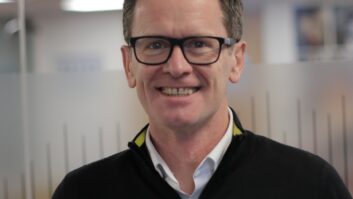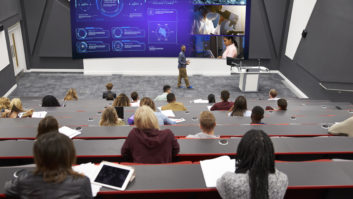
Major AV installation projects are complex and wide-ranging, involving a large number of partners and numerous risk factors. How can integrators ensure that projects don’t get derailed? Steve Montgomery reports.
Professional AV integrators are well aware that installing a large AV project is fraught with problems. The more they need to work with and depend on third parties, the greater the potential for complication. Communication, trust and reliance on external contractors, architects and clients means that there are a multitude of ways in which a project can go wrong – usually at the last minute – but often the onus to recover from issues falls on the AV integrator.
In many cases AV integration is the final part of a major new construction of office or education facilities or entertainment or sporting facilities. “The majority of large-scale projects suffer delays along the way, yet the final go-live date is often fixed, either by a scheduled event, like the Olympics or World Cup, or because of client commitment,” says Roland Hemming, consultant at RH Consulting. “The AV integration task is nearly always compressed; it is usually the last in a very long chain of jobs, and if everyone else is late, it falls on the AV integrator to recover the situation.”
Documentation
Documentation is needed on all projects as a fundamental requirement: if it is not submitted to a satisfactory level, this will generally prevent final project sign-off and payment. It therefore makes sense to prepare it early, before the installation team arrives on site, and use it for guidance as well as a communication tool with other trades. “Good documentation is critical to every project,” continues Hemming. “It specifies exactly what is proposed in visual and written form and provides the basis with which to communicate with all other parties.
“Another complication is that at the end of the project some of the AV team will have moved on to other projects and lost interest. So the motivation and commitment to providing good documentation at that stage is low – another reason for doing it as well as possible earlier.”
Paul Stevens, senior project manager, Reflex, agrees: “Keep your customer and supplier relationships in mind when it comes to documentation and communication. I don’t just mean the overall client and suppliers. Everyone involved within a project is, in some way, a customer and a supplier to each other, including your own team of colleagues. Those that receive information from others are clients and those that provide the information are suppliers. Everyone in the process deserves detailed, accurate and professional communications.
“The risk with poor documentation and communication is that assumptions are made, which result in mistakes, below-standard performance, deliverables not being met and additional costs being incurred. Good documentation and communication is vital to a successful project. My guide is to provide information in the format I’d like to receive it.”
It is the role of the project manager to ensure the smooth running and eventual success of the project. “The project manager is the lynchpin in every project, controlling all aspects of the installation and ensuring everyone is aware of what they have to do, as well as liaising with other contractors and the client,” says Ron Lewis, AVI-SPL’s director of process management. “The most important aspect of that role is communication: building an effective team and ensuring that each member understands their individual role in the project; to organise resources and enable effective communication among and beyond the team.”
An effective mechanism, Lewis believes, is the use of standard procedures based on previous successful projects: tried-and-tested procedures that have worked in the past. Within AVI-SPL these have been developed over years of experience. “We constantly use and re-use plans containing the basic task elements from previous projects and adjust to meet the specific requirement, which allows us to move quickly and minimise problems.”
Constructive pessimism
On an oil rig, the role of the safety supervisor is one of constructive pessimism: to consider the worst-case scenario in order to anticipate what might go wrong, and how potentially lethal situations can be prevented. Jim Trodden, now retired, was responsible for the health, safety and wellbeing of workers on a North Sea rig: “The industry motto is to ‘develop a case of chronic unease’, which is an application of negative thinking that gives a positive response: to imagine problems and envisage how to avoid them.” An interesting aspect of this is that a fail-safe condition for one party, such as cutting off electrical power in the event of a problem during an installation programme, might have enormous consequence to others, for example should all the lights go out.
While adverse events are generally not as life-threatening in the AV installation sector, risk and its associated assessment and consequences to a project can be quantified and better managed using similar techniques. Lewis again: “Risk assessment is linked to a generic set of defined procedures. We have a series of known risks that are consistently encountered; typical problems that we come across during installations, such as absence of furniture, restricted or non-access to working areas, non-arrival of critical devices etc. We have developed a risk register that is used on each project to develop plans to recover a situation, should a particular problem occur. This allows project managers to instantly invoke alternative strategies and communicate them to the team, thereby preventing the situation in which the team has to be assembled and the course of action discussed and agreed upon: activities that are time-consuming and inefficient.”
Hemming also recommends this strategy: “A recent major contract involved a risk register that contained over 2,500 individual items, each with an individual recovery procedure to mitigate risk. It is not simply a case of solving the problem in hand. Each one may have significant knock-on effects, so being able to think beyond that immediate issue and stop it stopping the task string is essential in recovery. For example, not having a piece of furniture may prevent the installation of some equipment, which may affect wiring and then programming and testing of the system in that room, causing a back-up of tasks further down the line. Recognising this and enabling tasks to be performed as parallel independent operations when necessary can keep the overall project on track.”
This procedure also allows better reporting through the creation of checklists and status reports. In his case Hemming used a system of green, amber or red flags on task items to indicate levels of concern.
Simon Colling, HEFE manager at CDEC, strongly believes that identifying and warning about potential problems is critical to the success of projects. “Project reporting includes logs that provide full visibility and complete transparency of the status of all tasks. In our case we find that a weekly-distributed Excel spreadsheet serves the purpose well, with individual tabs for areas of activity. Everyone can be made aware of what is happening across the whole project.”
He does, however, admit that this takes commitment: “On one particular project we were constantly being held up by the employing contractor, and despite consistently reporting the issues and potential risk to the project timescale, found that they were not actively engaging with us – mainly because they were not reading the logs. Unfortunately they were not well versed in AV technology so were not able to assess the implications. Ironically it is often easier to deal directly with the end customer, particularly in the education sector, as they have dedicated AV/IT support teams who do understand it.”
www.avispl.com
www.cdec.co.uk
www.reflex.co.uk
www.rhconsulting.eu







